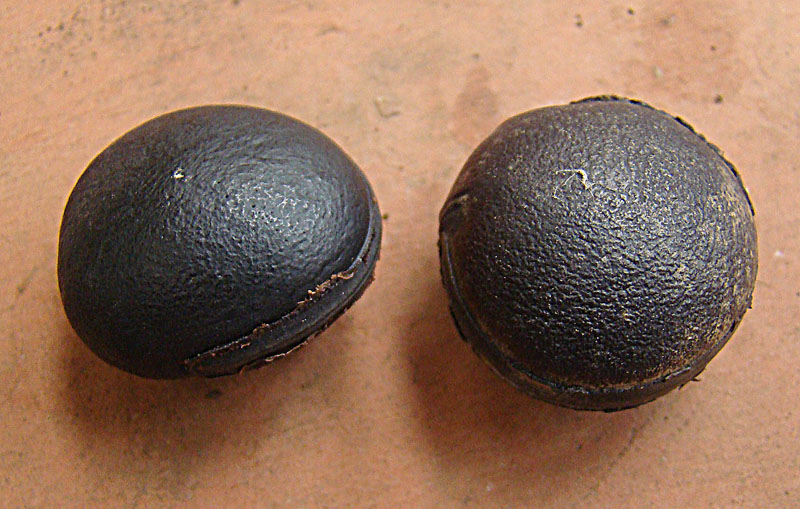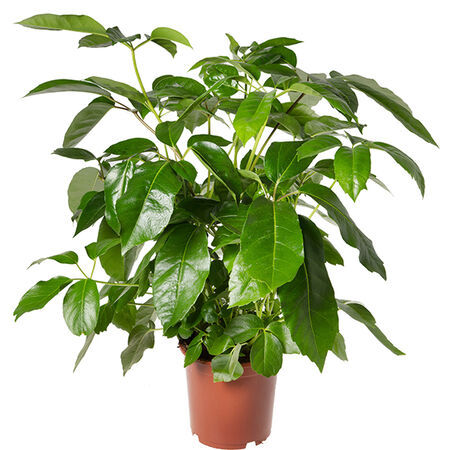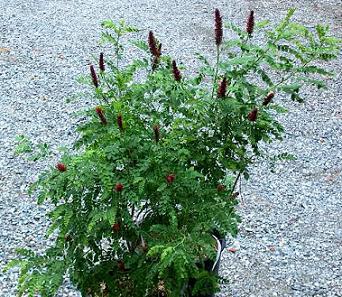
Seeds for Lawn and Shrub Plants

3352 Fragrant False Indigo ( Amorpha nana )
A compact erect shrub with green foliage. Leaves are alternate, odd-pinnate up to 1-4 inches long. The fragrant pink flowers appear in May through July.
The pink flowers have a delightful honey fragrance. Excellent container plant for use as a fragrant houseplant, and does well outside in almost all soils, drought tolerant.
Perennial. Hardy outside to zone 3.

JF946 Yellow Elder ( Yellow Trumpetbush ) ( Tecoma stans var. stans )
Yellow elder grows as a densely branched shrub or small tree and gets its common name from its superficial resemblance of its foliage to that of elderberry (Sambucus canadensis).
It has bright green opposite leaves, 2-3 inches long with sharply toothed edges. The smooth squarish twigs are green, turning tan or reddish tan as they age. The bark on the main trunk is light brown and becomes corky with age.
The 1-2 inch sunshine yellow flowers are trumpet shaped. They hang in showy clusters at the branch tips and forks, bending the twigs into arches with their weight. There are two folds along the bottom of the flower’s throat and several delicate rust-red lines decorating the interior. The blooms appear in flushes throughout the growing season.
They are followed by 4-8 inch long stringbean-like pods that hang in vertical clusters. These turn brown and split open to release flat oblong 1/4 inch seeds with transparent 1/4 inch wings on each end.
Common yellow elder is a Central and South American tree that grows to 25 ft. It has bright yellow flowers and dense, lushly green foliage that is evergreen in tropical climates, but deciduous in chillier places.
Yellow elder will grow on a wide variety of soils, including sand and limerock. The plants can be cut to the ground for rejuvenation in the early spring or carefully sheared during the growing season to control shape and size and promote new flushes of flowers.
This species needs full sun. Yellow elder likes well drained soil. Potted plants should be given minimal water when not in active growth. Hardiness: USDA Zones 7 – 11. Freeze tolerance varies dramatically, with some forms able to survive temperatures down to around 10 degrees and others severely injured by only a few degrees of frost.
Yellow elder is typically deciduous and may freeze back or have a rather awkward shape, so it is best set among more consistent shrubs where it can contribute color to a border or screen. The yellow blooms are spectacular behind blue agave. Since this species drops its abundant blossoms before they wither, it can advantageously be placed where the fallen blossoms will form a pool of gold on the ground. Nurserymen say yellow elder sells best when marketed as a flowering shrub in a 1-3 gal pot and promoted as a tropical patio plant.
Yellow elder has been used for a variety of purposes in herbal medicine. Its primary applications have been in treating diabetes and digestive problems. Extracts from Tecoma stans leaves have been found to inhibit the growth of the yeast infection, Candida albicans. Yellow elder also contains several compounds noted for their catnip-like effects on felines.
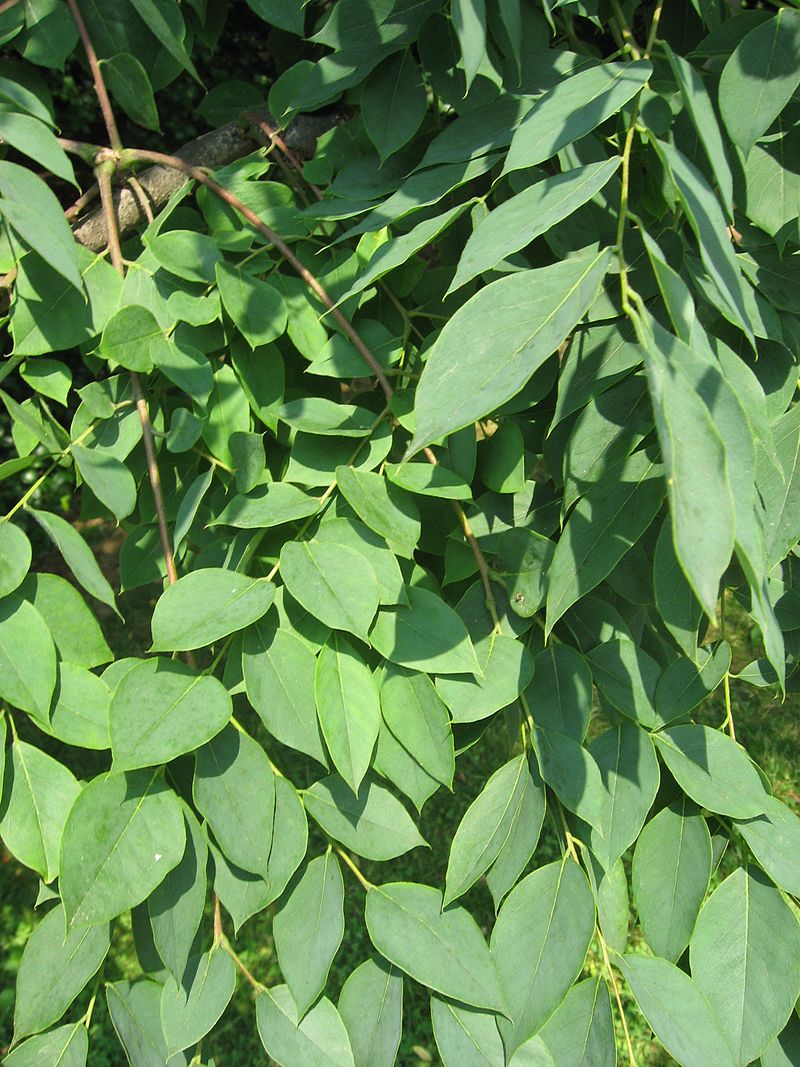
D1708 Kentucky Coffee Tree ( Gymnocladus dioica )
A large shade tree with long leaves that are pinkish in spring,
green in summer and yellow in fall. The seeds can be roasted
and eaten like nuts or made into a coffee substitute, however it should be noted that unroasted seeds may be toxic, so seeds must be roasted.
In addition to use as a food, the seeds of Kentucky coffee tree were used by Native Americans for ceremonial and recreational purposes. Seeds were used as dice in games of chance that were common in eastern tribes. The seeds were also used in jewelry.
It has been noted that the bruised foliage when sprinkled with sweetened water will attract and kill flies. Can be raised in containers when young.
Zones: 3 to 8.

3528 Incense Cedar ( Cedrus deodara )
Also known as Deodar Cedar, it is a large stately conifer with horizontal
spreading branches and a conical shape. It can grow to 150 ft
(45.7 m) tall with a 40 ft (12.2 m) spread at ground level.
More typically, though, they stay less than 50 ft (15.2 m) tall
but specimens in their native range have been found more than
200 ft (61 m) tall! Lower branches bend gracefully downward and
then up again. Branchlets are densely pubescent and droop
downward at the tips. The stiff, needle-like leaves are about 2
in (5.1 cm) long and borne in dense whorls of 20-30 per
cluster.
The bluish green female cones are 3-5 in (7.6-12.7 cm) long and
egg shaped. After two years they shatter and release little
seeds with papery wings. The bark is dark brown to nearly
black, smooth on young trees and becoming fissured with
age.
Deodar is native to the Himalayas, where it grows at elevations
of 3,500 to 12,000 ft (1,067-3,658 m) above sea level.
Deodar is fairly fast growing for the first decade or two,
growing as high as 30 ft (9.1 m) in its first 10 years. It is a
long-lived and troublefree tree in most areas. Deodar needs
neutral to alkaline soil.
Light: Full sun. (In whose shade is a 200 ft (61 m) tree going
to grow?)
Moisture: Once established, deodar is drought tolerant.
Hardiness: USDA Zones 7 – 9.
Most cultivars of deodar will grow into large and handsome
specimen trees that need plenty of room. Use these in the back
of a large landscape so they can be seen in their entirety.
From a distance, deodar is dense and plumose, with a fine
texture, and the tip of the tree seems to wave in the breeze.
Some cultivars are smaller and more shrublike. With proper
pruning most deodars can be maintained as bushy shrubs.

SF300 Moroccan Broom ( Cytisus battandieri )
Also known as Pineapple Broom, this Moroccan native is a popular small tree with soft, velvety, mostly evergreen foliage and wonderfully scented clusters of bright yellow flowers. It is the perfect choice for small gardens. It is tolerant of heat and drought as well as cold and severe freezes and will do well in temperate climates from USDA Zones 7 to 10. Propagation is easy from seeds soaked overnight.
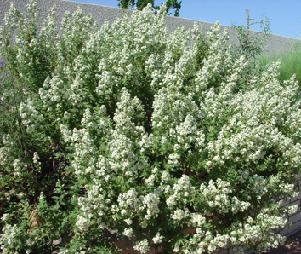
LET009 Fern Bush ( Chamaebatiaria millefolium )
Also known as Desert Sweet, Fernbush is a popular plant in the southwest. The long bloom period begins in mid-June and will often last into August. Fernbush also gives the appearance of being an evergreen shrub in the winter, due to having foliate buds. Fernbush leaves are highly ornamental, with a pleasing deep olive-green color, and a wonderful smoky, herbal aroma. In many mild to moderate winter climates, the foliage is semi-evergreen.
Fernbush is a shrub that grows to 7 feet tall by 7 feet wide, depending on the amount of watering and the zone in which it is planted. It is hardy in zones 5-8, from 4,500 to 7,000 feet in altitude, and should be planted in full sun. It requires moderate watering when planted but can be very drought tolerant when mature. Fernbush can be spectacular as a specimen plant, as well as a hedge or windbreak. It is native to the western states from California through to Arizona and Northern New Mexico’s scrublands, woodlands and forests.
Native bees, bumblebees, honeybees, moths and butterflies love the nectar-rich flowers. And many beneficial insects are associated with Fernbush. But unlike lilacs that have little to offer after blooming, Fernbush flowers are followed by attractive bronze seed heads that adorn the plants through winter, catching the snow and providing pleasing muted-brown color in the dormant seasons.
Once established in the garden this is an extremely low water usage plant. In their native habitat these shrubs grow with grasses and cacti. Native Americans would make a tea from the leaves to settle up-set stomachs. These plants tolerate shearing and pruning well. Fernbush gets is name from the deeply cut and lacy textured foliage. The foliage is pleasantly aromatic when you brush against the plant or are cutting it back. The mature stems exhibit a colorful cinnamon colored sheen, adding yet another attractive feature.
Showy clusters of white flowers add a pretty effect in early summer. Being native to the Colorado Plateau, fernbush combines in the garden well with other western natives such as Arctostaphylos and Penstemon, as well as with ornamental grasses. It may also be planted as a hedge border in dry difficult areas of your garden. This is an extremely useful and low maintenance for drier garden areas.
Seeds will need to be fall planted or cold stratified.
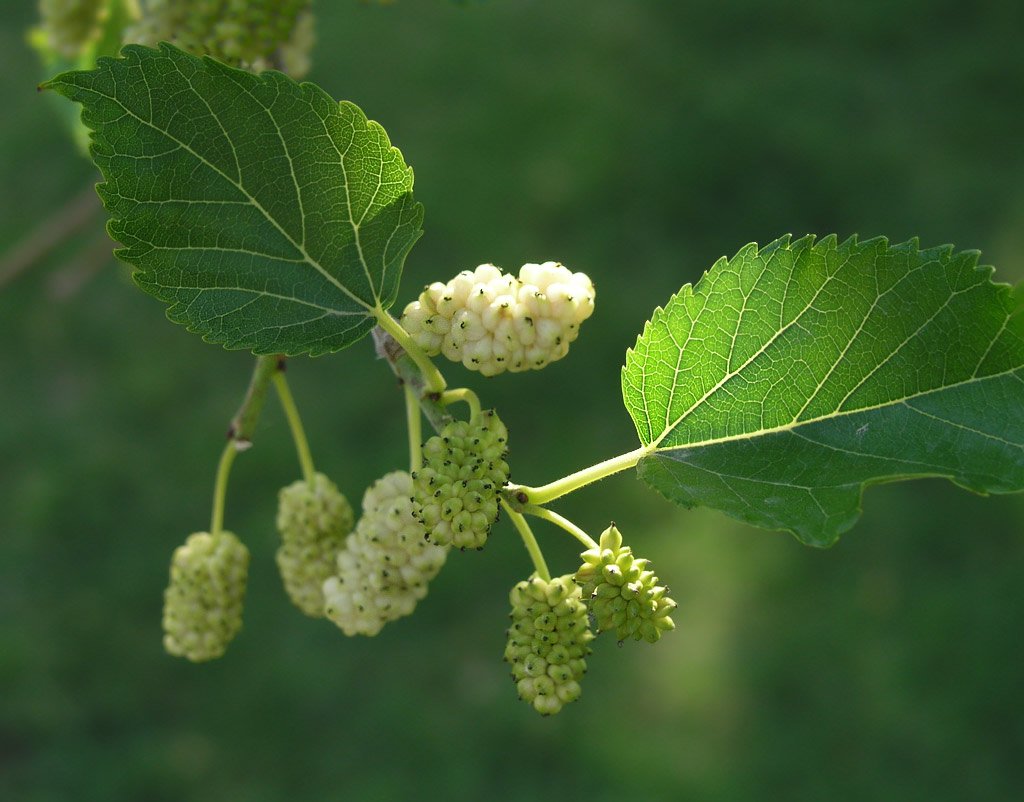
D2225 Russian Mulberry Tree ( Morus Alba )
Commonly called white mulberry, this is native to China. It is a rounded, fast-growing, deciduous tree that typically grows to 30-50′ tall and as wide. It usually develops a wide-spreading crown with age. The leaves of this tree have been used in China since at least 2600 B.C. as the primary diet for silkworms used to make silk. Trees were introduced into North America in colonial times in an effort to establish a silk industry. Although the industry never took hold, the trees did take hold and have over time escaped cultivation and naturalized in fields, waste areas, forest margins and along roads throughout much of the U.S.
This tree has also been planted in various areas for erosion control and windbreaks. White mulberry is usually dioecious (separate male and female trees), but sometimes is monoecious. Small yellowish-green flowers in drooping catkins bloom in spring (March-April). Fertilized flowers on female trees are followed by sweet, edible blackberry-like fruits (cylindrical drupes to 1″ long) that mature in June. Fruits ripen to white or pink, but sometimes to darker reds or purple-blacks. Fruits are loved by birds.
Best suited for zones 4-9.
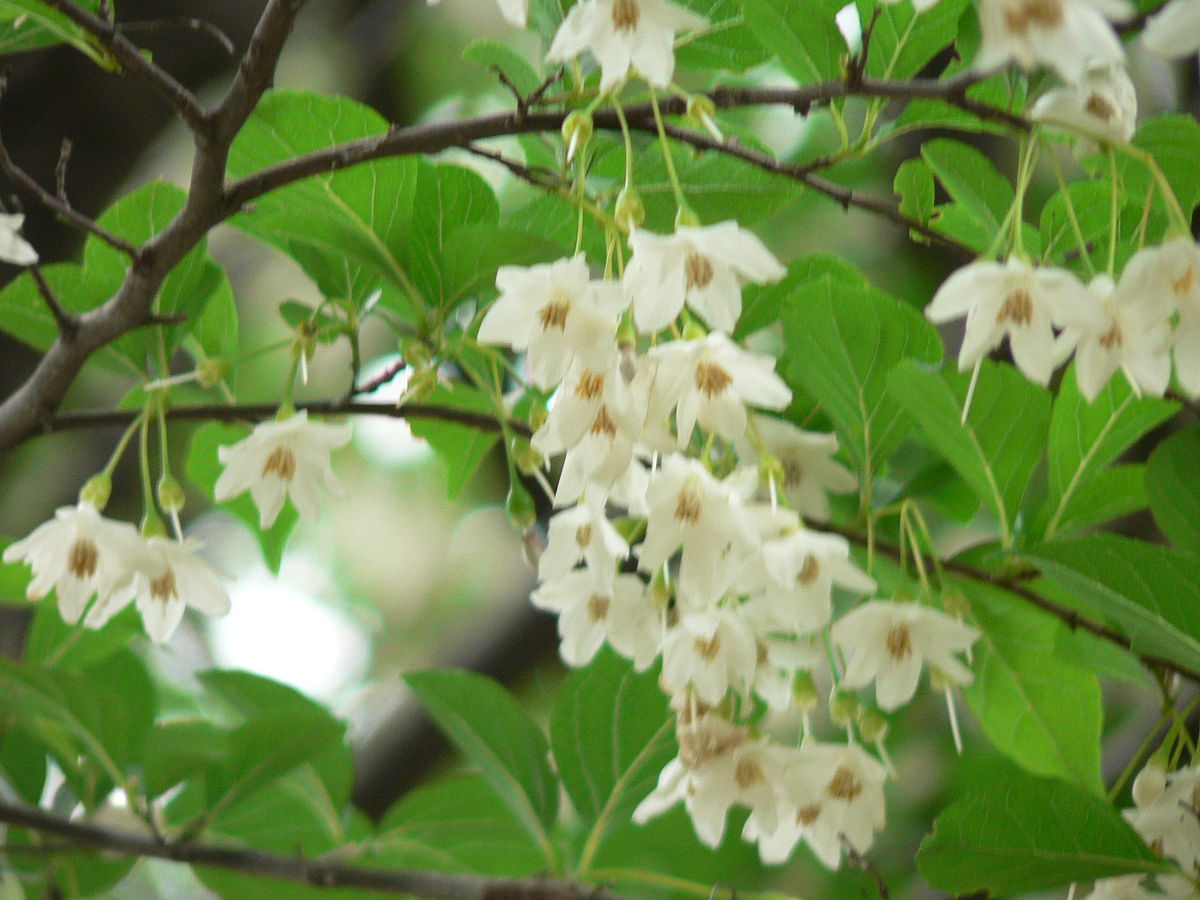
TRZ047 Japanese Snowbell ( Styrax japonicus )
Japanese snowbells is a compact, deciduous tree with a graceful spreading habit. In late spring, it produces hanging clusters of sweetly scented, bell-shaped white flowers. Minutely toothed, bright green leaves have a clean, fresh look in all but the driest conditions. Attractive fine twigs are borne on slender, somewhat-layered branches, and the bark is a smooth gray-brown.
Native to China , Japan, and Korea, best suited for zones 6-8.
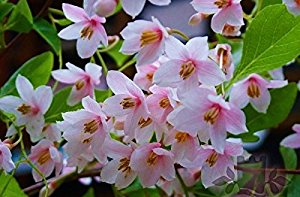
TRZ048 Pink Japanese Snowbell ( Styrax japonicus rosea )
Pink Japanese snowbells is very simliar to the white snowbell, ie. a compact, deciduous tree with a graceful spreading habit. In late spring, it produces hanging clusters of sweetly scented, bell-shaped white with pinkish tink flowers. Minutely toothed, bright green leaves have a clean, fresh look in all but the driest conditions. Attractive fine twigs are borne on slender, somewhat-layered branches, and the bark is a smooth gray-brown.
Native to China , Japan, and Korea, best suited for zones 6-8.
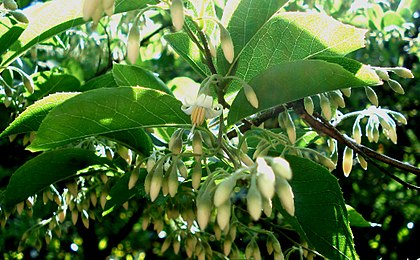
TRZ049 Chinese Snowbell ( Styrax dasyanthus )
The Chinese snowbell tree is differentiated from the others most notably in the leaves which are larger and more pale, making the foliage an even better back-drop for the delicate, bell-shaped flowers that occur in spring.
These blossoms are held in drooping, racemes along light branches and are immaculately white with golden stamens. The spreading, open branching displays the bloom to best effect along with the mid-green foliage which turns beautiful shades of red and gold in autumn.
Chinese snowbell tree only reaches 25 feet with a 20 foot spread when grown along a woodland verge, and is somewhat smaller when grown in full sun. It prefers moist, slightly acidic, well-drained soils. It fits well in the modern garden as well as in naturalized settings.
Best suited for zones 6-8.
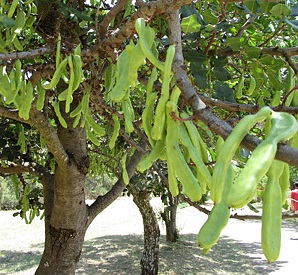
D2249 Carob Tree ( Ceratonia )
Ceratonia siliqua, commonly known as the carob tree, St John’s-bread, or locust bean is a species of flowering evergreen shrub or tree in the pea family, Fabaceae.
It is widely cultivated for its edible pods, and as an ornamental tree in gardens. The ripe, dried pod is often ground to carob powder, which is used to replace cocoa powder. Carob bars, an alternative to chocolate bars, are often available in health-food stores.
Carob consumed by humans is the dried (and sometimes roasted) pod. The pod consists of two main parts: the pulp accounts for 90% and the seeds for 10% of the pod weight.
Carob is mildly sweet and is used in powdered, chip or syrup form as an ingredient in cakes and cookies, and as a substitute for chocolate. Carob bars are widely available in health food stores. A traditional sweet, eaten during Lent and Good Friday, is also made from carob pods in Malta. Dried carob fruit is traditionally eaten on the Jewish holiday of Tu Bishvat.
While chocolate contains levels of theobromine which are toxic to some mammals, carob contains significantly less caffeine and theobromine, and is therefore used to make chocolate-flavored treats for dogs.
Carob pod meal is used as an energy-rich feed for livestock, particularly for ruminants, though its high tannin content may limit its use. Carob pods were mainly used as animal fodder in the Maltese Islands, apart from times of famine or war when they formed part of the diet of many Maltese. In the Iberian Peninsula, carob pods were used to feed donkeys.
The carob tree is native to the Mediterranean region, including Southern Europe, Northern Africa, the larger Mediterranean islands; to the Levant and Middle-East of Western Asia into Iran; and to the Canary Islands and Macaronesia.
Carob trees may be grown in USDA zones 9-11.

3385 Tea Olive ( Osmanthus fragrans )
Tea olive has deliciously fragrant flowers that smell a lot like those of fringetree (Chionanthus virginicus), which is in the same family. Tea olive is a traditional element in the southern garden landscape and a whiff of its scent carried on a cool winter breeze makes a memorable impression.
Tea olive is a large upright shrub that can reach 20 ft (6.1 m) tall and 6-8 ft (1.8-2.4 m) wide, but is usually seen in landscapes at 6-10 ft (1.8-3.1 m) high. The opposite leaves are a dark, shiny green and the edges may be finely toothed or smooth with both types present on the same individual. As the plant matures, most of the foliage is held at the outermost ends of the stems, but the plant retains a handsome appearance despite the legginess. In autumn, winter and early spring white flowers cover the shrub. It also blooms sporadically throughout the summer.
Individually the blossoms are small and inconspicuous, but the fragrance is powerful and exquisite.
Tea olive is rather slow growing and is usually quite long lived.
Tea olive prefers reasonably good soil, but is adaptable except in the poorest, sandy soil. May be pruned to maintain size and encourage branching, but thrives equally well with neglect. Tea olives are sometimes attacked by scale insects, but usually only when growing conditions are poor.
Light: Sun to partial shade; morning sun with afternoon shade, or high, shifting shade is ideal.
Plant tea olives where their lovely fragrance can be enjoyed! Situate a tea olive wherever there is foot traffic near windows or doors and in outdoor sitting areas. Incorporate tea olive into foundation plantings at the corners or use as an accent between windows. A row of tea olive makes a very attractive hedge or screen. In areas where it is tender, grow tea olive as a container specimen so it can be protected indoors in winter.
USDA Zones 8 to 10.

3469 Gopher Spurge ( Euphorbia latyrus )
We have had many requests for these seeds. The plant is said to produce a acrid milky juice in its roots that gophers cannot stand. It is said one should plant several of these plants in the yard and garden to discourage the pests.( We have no ideal if this is effective or not, but we do make them available for customers who want to try ).
Gopher Purge or Mole Plant contains a latex like milky sap that is found in the roots, leaves and flowers which can cause skin irritation in sensitive people. This caustic substance is not a repellant but a contact irritant.
The varmint must chew the roots to become ill or die. In order to protect plants from gophers or moles, a thick stand of Gopher Spurge planted in the gopher’s main tunnel is necessary. And, because it is a biennial, it dies every two years, but it does reseed itself very well so you should have new plants springing up each year.
All parts of the plant, including the seeds and roots are poisonous. Handling may cause skin irritation as the plant produces latex. While poisonous to humans and most livestock, goats sometimes eat it and are immune to the toxin. However, the toxin can be passed through the goat’s milk.
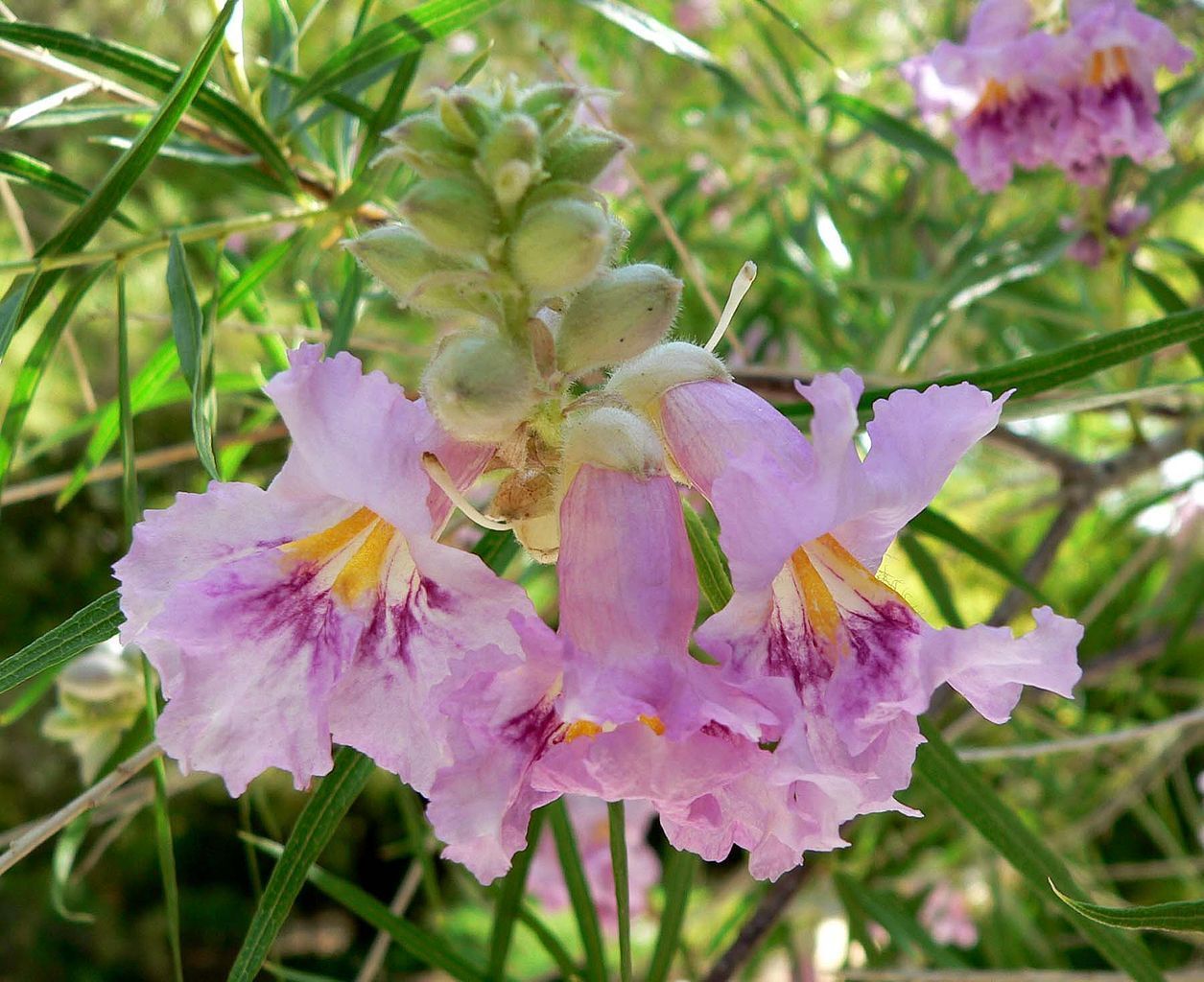
3643 Desert Willow ( Chilopsis linearis )
Desert willow, Chilopsis linearis is a large deciduous shrub or small tree.
Hummingbirds love this plant when in bloom and will hang around it most of the summer.
Its willow like, long, narrow leaves and growth along desert washes give the desert willow its name.
The Penstemon like flowers are fragrant, pink to lavender. They appear in May and keep coming until September or frost. Likes moderate water and sun. Does best inland and in desert.
This is a great plant for a bird garden, rock garden, xeriscape or lawn specimen.
Best suited for zones 6-10.
TRZ035 Bronze Loquat ( Eriobotrya deflexa )
Here is a lovely tree that has everything going for it, everything that is except cold hardiness. This is one of the more tropical loquats and is even more limited in range than its better known cousin, the Japanese loquat, or Eriobotrya japonica. But the lack of cold tolerance may not be too big of a problem if it is kept in mind that Bronze loquat is small enough for pot culture or could be accommodated in most greenhouses and its assets are so excellent that its more than worth the extra effort. And for those who live in warm weather areas such as the southern USA, then this is a must-have garden treasure.
Bronze loquat has a neat habit and compact growth making it an ideal specimen or patio tree, or even street tree since it can be grown beneath power lines. It also blends well into a shrub border and can be espaliered against a south facing wall.
Bronze loquat only reaches a height of 15 to 20 feet with a 10 to 15 foot spread if grown in full sun. Its chief asset is the large, heavily textured, evergreen leaves, which, when emerging in spring, are bright red-bronze and burnished copper. And they maintain this color for a considerable period of time before eventually turning a rich dark green for summer.
In addition to the striking foliar display there are small, white flowers, produced on showy panicles in spring. The flowers are also fragrant and will perfume your garden for weeks. These are followed by small fruits, similar to the Japanese loquat but not as palatable, though the wildlife will appreciate them.
Bronze loquat should be well watered until established, but can then survive periodic droughts. It should not be over fertilized since this may increase the risk of fire blight. Other than that it is quite healthy and maintenance free. It is a great choice for warm winter areas or the conservatory.
Zones 9-11.
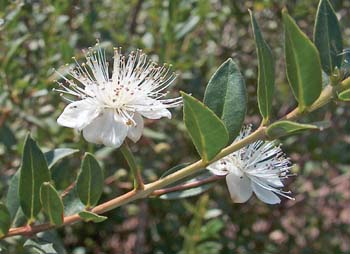
IP181 Greek Myrtle
( Myrtus communis )
An evergreen perennial that is hardy in zones 8-10, it is often grown in containers as a houseplant or patio plant.
This classic evergreen shrub from the Mediterranean. Fragrant white flowers and leaves are used in potpourri. Spicy leaves can be used in cooking like bay leaf. Essential oil is used for fragrance. Lovely house plant.
A broadleaf evergreen shrub or small tree that is native to the Mediterranean region. It typically grows to 5-6′ tall ( smaller in containers ), but may reach 15-20′ over time. Pointed, glossy dark green leaves to 2″ long are strongly aromatic when bruised.
White aromatic flowers (3/4″) with many yellow tipped stamens bloom in late spring/summer (May-July). Flowers are followed by blue-black berries.
Berries are edible and may be eaten raw, but are at best moderately tasteful. Dried flowers, leaves and fruits are used to flavor foods. Leaves are sometimes used as a substitute for bay leaves. Fresh flowers may be added to salads. Wood and leaves are added to charcoal to flavor grilled meats.
Dormant seeds are a bit more difficult than other seeds, but follow instructions on seed packet and you should have no problems.
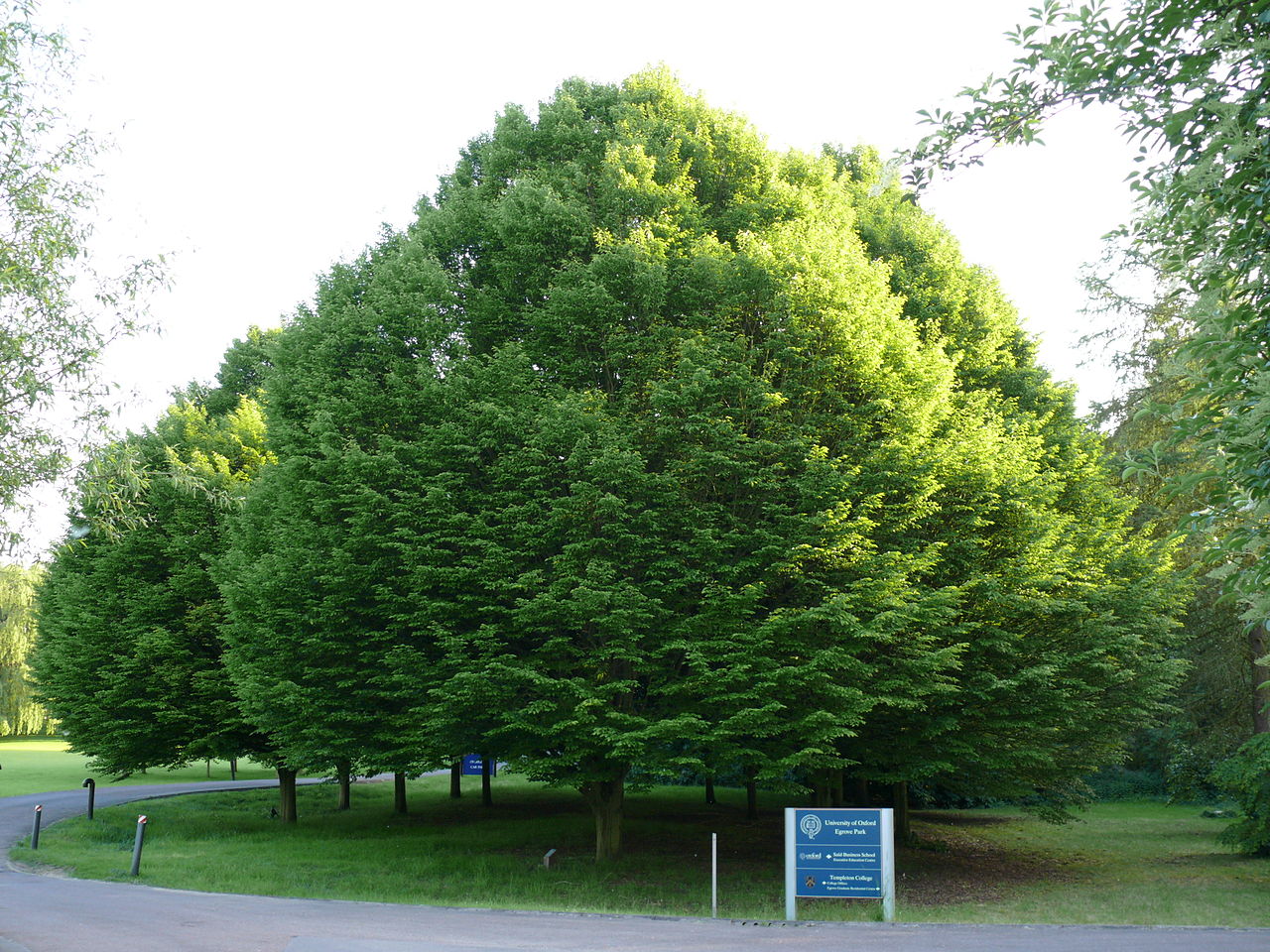
B1719 European Hornbeam ( Carpinus betulus )
A low maintenance tree that can be used as a hedge, shade tree, lawn or street tree. It has showy flowers in spring and good colored leaves in fall. Grows in most soils and tolerates air pollution well.
A medium-sized, deciduous tree that grows 40-60′ tall with a pyramidal to oval-rounded crown. Ovate, sharply-toothed, dark green leaves (to 5″ long) are clean and attractive throughout the growing season. Foliage turns yellow to orange in fall.
Fruits are small nutlets that appear in drooping 5″ long clusters in summer. Trunks have smooth gray bark and distinctive muscle-like fluting.
For zones 4-8.
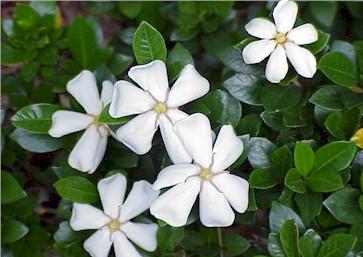
FA01 Gardenia ( Gardenia Jasminodes )
Also know as Cape Jasimine, native to China, Gardenia’s evoke
images of exotic, sweet-scented flowers and soft, island
breezes. Glossy, dark green leaves provide a luxuriant backdrop
to heavily-scented, double, creamy-white blooms. Grown in
dappled shade, Gardenia’s like well amended and well drained (
5-6 pH ) acid soil and will reach a height of 4-6 feet. Blooms
are long lasting and are ideal for cut flowers. Hardy to 20 F.
and in zones 8-10.
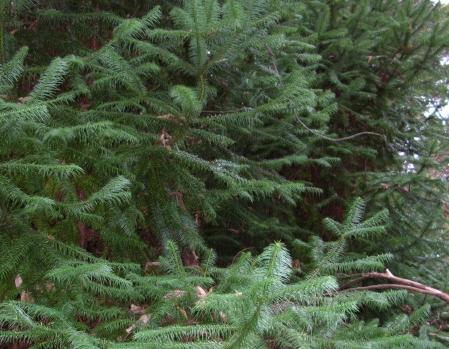
Image: by Forest & Kim Starr
SF089 China Fir Tree ( Cunninghamia lanceolata )
An evergreen tree well suited for zones 7-9. Does well in full sun or partial shade, likes well drained soil, but will tolerate damp, heavy clay. Grows to about 30-75 feet tall, and spreads to 20-30 feet, but makes a wonderful bonsai plant as well.
Has bright green to blue green flat needles; sharp point on end; may discolor in winter to bronze green and bears unique small squarish cones.
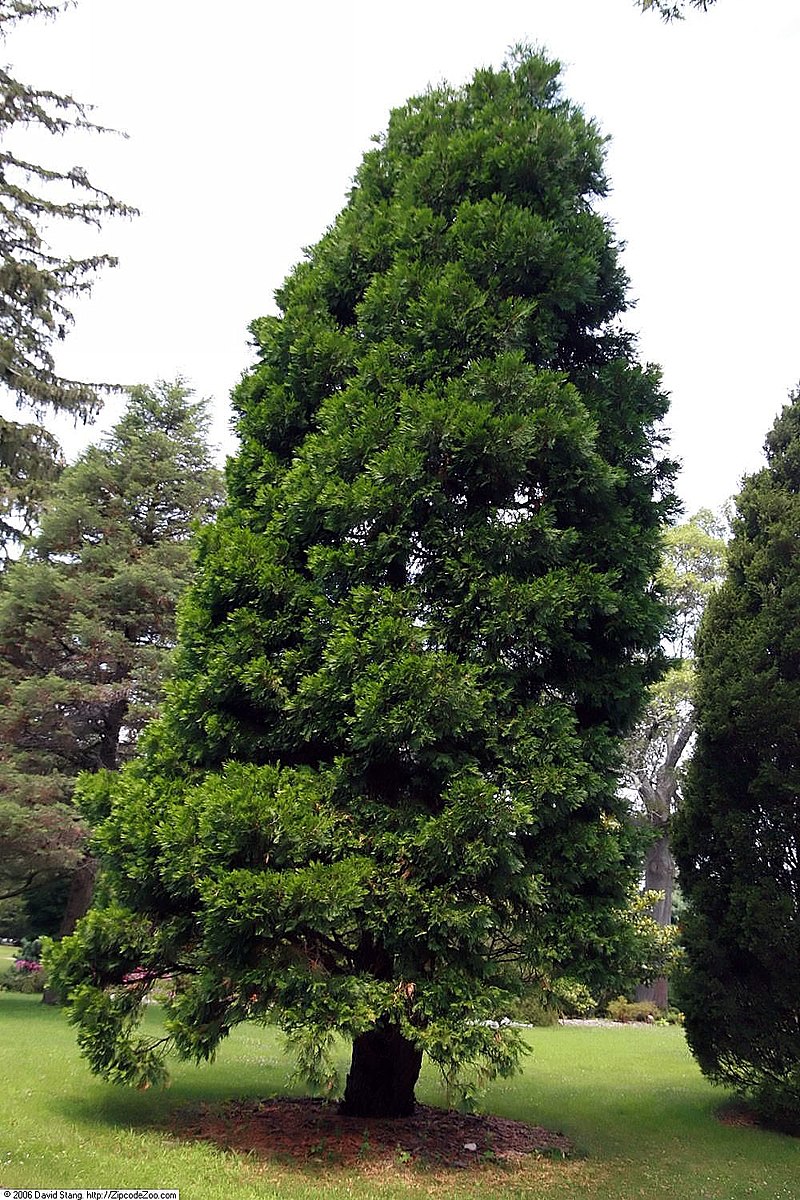
B1708 Incense Cedar ( Calocedrus decurrens )
A small pyramidal shaped cedar that is prized for its very fragrant leaves and wood. Easy to start from seeds. A very beautiful bonsai specimen.
Incense cedar is an evergreen tree with a skinny, columnar shape in youth, becoming only a little more rounded at maturity. In its native habitat it can get as large as 150 ft (45.7 m) tall with a trunk diameter of 6 ft (1.8 m). In these very large trees, the long straight trunk is swollen and buttressed at the base and usually free of branches for half its length.
Incense cedar does best on well-drained, slightly acidic sandy loams in cool, mountainous areas. Outside its natural range it tends to stay smaller and bushier. Even under ideal conditions, incense cedar is a slow growing tree. But, it can live 1000 years or more. Grows in full sun or part shade. Incense cedar needs lots of moisture to realize its full potential as a large tree. If it gets less water than ideal it will survive, but remain as a smaller, bushy, but still attractive specimen. Hardiness: USDA Zones 6 – 8. Incense cedar does quite well in zones 7 and 8, but usually doesn’t get as large as it does up north.
Propagation: Incense cedar is difficult, but not impossible, to propagate from cuttings.
The generic name means “beautiful cedar”, and that it is. The tall, columnar incense cedar is a handsome specimen for framing a formal landscape. A line of them, like soldiers at attention, adds a formal dimension to driveways and makes a great windbreak or tall screen.
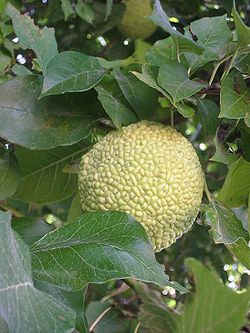
D1717 Osage Orange ( Maclura )
A fast growing shrub often grown as a hedge. Pretty foliage with greenish flowers. Good
as a background or border plant.
Recent research suggests that elemol, another component extractable from the fruit,
shows promise as a mosquito repellent with similar activity to DEET in contact and
residual repellency.
Notes:The Osage-orange is commonly used as a tree row windbreak in prairie states,
which gives it one of its colloquial names, “hedge apple”. It was one of the primary trees
used in President Franklin Delano Roosevelt’s “Great Plains Shelterbelt” WPA project,
which was launched in 1934 as an ambitious plan to modify weather and prevent soil
erosion in the Great Plains states, and by 1942 resulted in the planting of 30,233
shelterbelts containing 220 million trees that stretched for 18,600 miles (29,900 km).
The sharp-thorned trees were also planted as cattle-deterring hedges before the
introduction of barbed wire and afterward became an important source of fence posts.
The heavy, close-grained yellow-orange wood is very dense and is prized for tool
handles, treenails, fence posts, electrical insulators, and other applications requiring a
strong dimensionally stable wood that withstands rot. Straight-grained osage timber (most
is knotty and twisted) makes very good bows. In Arkansas, in the early 19th century, a
good Osage bow was worth a horse and a blanket. Additionally, a yellow-orange dye can
be extracted from the wood, which can be used as a substitute for fustic and aniline dyes.
When dried, the wood has the highest BTU content of any wood, and burns long and hot.
Today, the fruit is sometimes used to deter spiders, cockroaches, boxelder bugs, crickets,
fleas, and other arthropods.
Leaves turn bright yellow in fall, thorny branches, bears inedible round fruit 3-5″ in
diameter. The fruit is prized for it’s ability to repel insects and spiders when scattered
around home foundations. The crushed fruits of this plant are said to attract and kill
cockroaches. Can be raised as container plant in northern states.
The wood is sought after for recurve bow making. Both male and female plants are
needed to produce fruit. The ratio of male/female plants the seeds produce is up to mother
nature, but a pack of 10 seeds always produces a mix of male/female plants in all of our
previous field trials. Can be grown in zones 4-9.
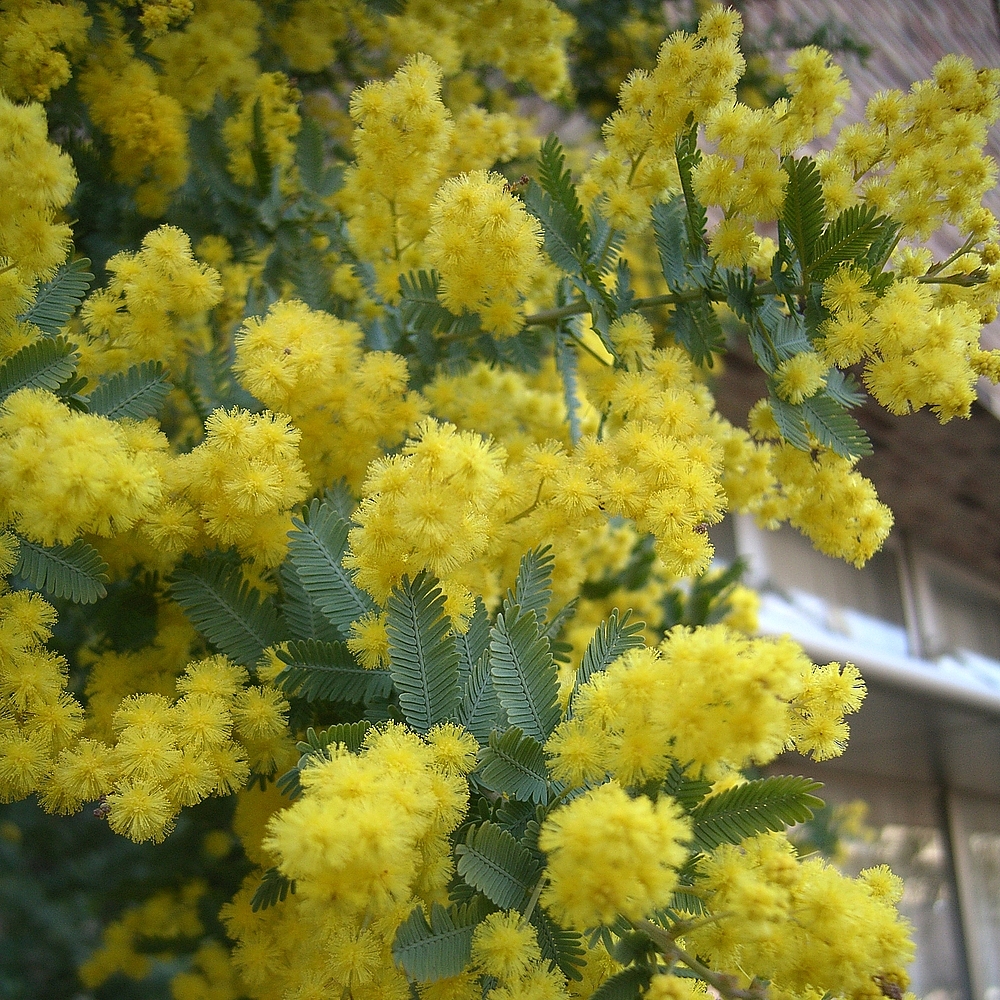
D1164 Golden Mimosa ( Acacia baileyana )
Australia. Small graceful tree well adapted to growing inside.
Has such a profusion of beautiful flowers that they seem to
cover the entire plant. Cold hardy to 18 degrees outside.

D1717 Osage Orange ( Maclura )
A fast growing shrub often grown as a hedge. Pretty foliage with greenish flowers. Good
as a background or border plant.
Recent research suggests that elemol, another component extractable from the fruit,
shows promise as a mosquito repellent with similar activity to DEET in contact and
residual repellency.
Notes:The Osage-orange is commonly used as a tree row windbreak in prairie states,
which gives it one of its colloquial names, “hedge apple”. It was one of the primary trees
used in President Franklin Delano Roosevelt’s “Great Plains Shelterbelt” WPA project,
which was launched in 1934 as an ambitious plan to modify weather and prevent soil
erosion in the Great Plains states, and by 1942 resulted in the planting of 30,233
shelterbelts containing 220 million trees that stretched for 18,600 miles (29,900 km).
The sharp-thorned trees were also planted as cattle-deterring hedges before the
introduction of barbed wire and afterward became an important source of fence posts.
The heavy, close-grained yellow-orange wood is very dense and is prized for tool
handles, treenails, fence posts, electrical insulators, and other applications requiring a
strong dimensionally stable wood that withstands rot. Straight-grained osage timber (most
is knotty and twisted) makes very good bows. In Arkansas, in the early 19th century, a
good Osage bow was worth a horse and a blanket. Additionally, a yellow-orange dye can
be extracted from the wood, which can be used as a substitute for fustic and aniline dyes.
When dried, the wood has the highest BTU content of any wood, and burns long and hot.
Today, the fruit is sometimes used to deter spiders, cockroaches, boxelder bugs, crickets,
fleas, and other arthropods.
Leaves turn bright yellow in fall, thorny branches, bears inedible round fruit 3-5″ in
diameter. The fruit is prized for it’s ability to repel insects and spiders when scattered
around home foundations. The crushed fruits of this plant are said to attract and kill
cockroaches. Can be raised as container plant in northern states.
The wood is sought after for recurve bow making. Both male and female plants are
needed to produce fruit. The ratio of male/female plants the seeds produce is up to mother
nature, but a pack of 10 seeds always produces a mix of male/female plants in all of our
previous field trials. Can be grown in zones 4-9.

B1708 Incense Cedar ( Calocedrus decurrens )
A small pyramidal shaped cedar that is prized for its very fragrant leaves and wood. Easy to start from seeds. A very beautiful bonsai specimen.
Incense cedar is an evergreen tree with a skinny, columnar shape in youth, becoming only a little more rounded at maturity. In its native habitat it can get as large as 150 ft (45.7 m) tall with a trunk diameter of 6 ft (1.8 m). In these very large trees, the long straight trunk is swollen and buttressed at the base and usually free of branches for half its length.
Incense cedar does best on well-drained, slightly acidic sandy loams in cool, mountainous areas. Outside its natural range it tends to stay smaller and bushier. Even under ideal conditions, incense cedar is a slow growing tree. But, it can live 1000 years or more. Grows in full sun or part shade. Incense cedar needs lots of moisture to realize its full potential as a large tree. If it gets less water than ideal it will survive, but remain as a smaller, bushy, but still attractive specimen. Hardiness: USDA Zones 6 – 8. Incense cedar does quite well in zones 7 and 8, but usually doesn’t get as large as it does up north.
Propagation: Incense cedar is difficult, but not impossible, to propagate from cuttings.
The generic name means “beautiful cedar”, and that it is. The tall, columnar incense cedar is a handsome specimen for framing a formal landscape. A line of them, like soldiers at attention, adds a formal dimension to driveways and makes a great windbreak or tall screen.

3182 Firethorn ( Pyracantha coccinea )
is a large, evergreen shrub that is cherished for its
spectacular fall and winter display of scarlet fruits and
ability to withstand dry and droughty conditions. Shooting long
lanky stems in all directions, firethorn typically grows into a
tangled mound up to 10 ft (3.1 m) in height and 12 ft (3.7 m)
wide. It is armed with sharp thorns that hide among the dark,
glossy green leaves.
Clusters (corymbs) of small white flowers appear in spring.
These are up to 2 in (5 cm) across and are borne close together
creating the appearance of nearly solid surface of flowers. In
fall the 1/4 in (0.6 cm) berries begin to ripen, their color
mellowing from green to shades of red, orange, or yellow. These
persist through winter and into early spring depending on
climate and appetite of the local bird population. Under bright
sunny conditions the berries are plentiful but expect smaller
crops in shadier situations. The color of both leaves and
berries tends to be darker in cooler climates.
Culture: Not particular about soil and requires little or no
supplemental fertilization.
Light: Full sun preferred but will grow in partial to fairly
heavy shade. Flowering and fruiting will not be as heavy.
Moisture: Moist to very dry, well drained soil. Hardiness:
Zones 5 – 9.
Usage: Pyracantha is often used as an espalier. Held flat
against a wall, it can be shaped quite creatively. Because of
its fast growth rate, sprawling, spreading habit, and ease of
care, it can be used on slopes to great advantage requiring
little maintenance or care. The wide-reaching stems may be
pruned back as needed during warm weather as the shrub blooms
on old wood. Even consider using it as an informal hedge! This
will require some trimming and shaping for the first few years
but the effort will produce impressively beautiful and secure
(thorny) hedges.
Landscapers love the firethorns for their fast rate of
growth and ability to withstand drought and neglect. The shrubs
ruggedness and disease and pest resistance makes this plant a
very popular item in commercial landscapes.
Source link

